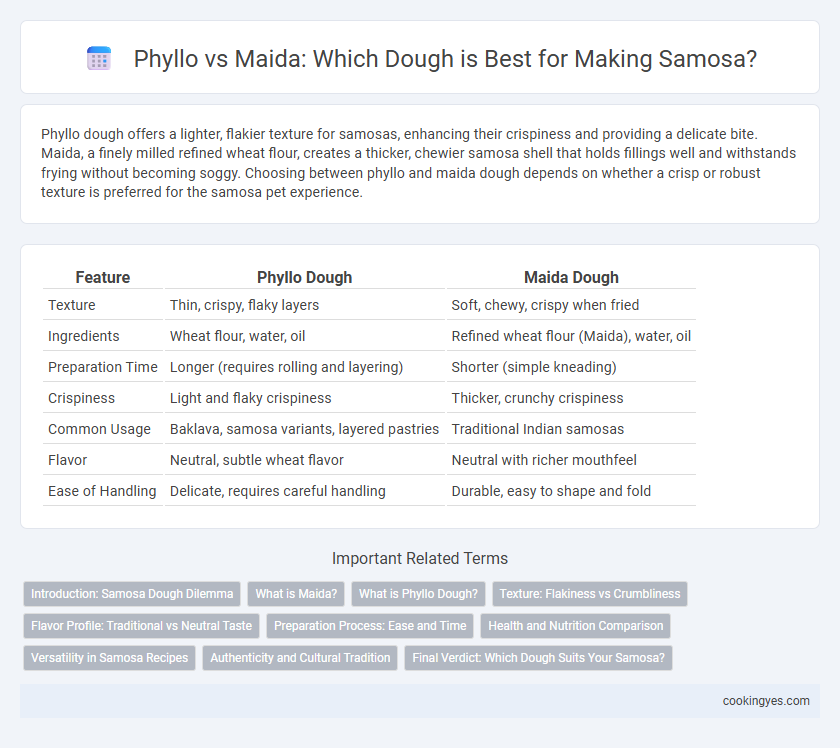Phyllo dough offers a lighter, flakier texture for samosas, enhancing their crispiness and providing a delicate bite. Maida, a finely milled refined wheat flour, creates a thicker, chewier samosa shell that holds fillings well and withstands frying without becoming soggy. Choosing between phyllo and maida dough depends on whether a crisp or robust texture is preferred for the samosa pet experience.
Table of Comparison
| Feature | Phyllo Dough | Maida Dough |
|---|---|---|
| Texture | Thin, crispy, flaky layers | Soft, chewy, crispy when fried |
| Ingredients | Wheat flour, water, oil | Refined wheat flour (Maida), water, oil |
| Preparation Time | Longer (requires rolling and layering) | Shorter (simple kneading) |
| Crispiness | Light and flaky crispiness | Thicker, crunchy crispiness |
| Common Usage | Baklava, samosa variants, layered pastries | Traditional Indian samosas |
| Flavor | Neutral, subtle wheat flavor | Neutral with richer mouthfeel |
| Ease of Handling | Delicate, requires careful handling | Durable, easy to shape and fold |
Introduction: Samosa Dough Dilemma
Phyllo and maida offer distinct textures and flavors for samosa dough, influencing the crispiness and mouthfeel of the final snack. Maida, a refined wheat flour, creates a thicker, chewier crust perfect for traditional stuffed samosas, while phyllo pastry provides a lighter, flakier alternative that crisps quickly during frying or baking. Understanding the unique properties of phyllo versus maida helps samosa makers achieve the ideal balance of crunch and softness based on regional preferences and cooking methods.
What is Maida?
Maida is a finely milled refined wheat flour commonly used in Indian cooking, especially for making traditional samosa dough due to its smooth texture and elasticity. Unlike phyllo, which is a thin, layered pastry dough used in Middle Eastern and Mediterranean cuisines, maida provides a sturdier structure that holds the samosa filling well during deep frying. Its high gluten content ensures a crispy and flaky crust, making maida the preferred choice for authentic samosas.
What is Phyllo Dough?
Phyllo dough, a traditional Mediterranean pastry, consists of paper-thin layers made from flour, water, and a small amount of oil or vinegar, creating a delicate and crisp texture when baked or fried. Unlike maida, which is refined wheat flour used to make a thicker and softer samosa dough, phyllo offers a lighter, flakier shell ideal for creating a crisp exterior without the heaviness. Its unique layering technique results in a distinct crunch that sets phyllo-based samosas apart in texture and taste.
Texture: Flakiness vs Crumbliness
Phyllo dough creates samosas with a delicate, flaky texture due to its thin, layered sheets that crisp up beautifully when fried or baked. In contrast, maida-based samosa dough yields a crumbly and slightly denser texture, providing a sturdier bite that holds the filling well without excessive flakiness. The choice between phyllo and maida significantly impacts the samosa's mouthfeel, with phyllo favoring light, crisp layers and maida delivering a robust, crumbly structure.
Flavor Profile: Traditional vs Neutral Taste
Phyllo dough offers a crisp, flaky texture with a slightly buttery and rich flavor that complements spiced samosa fillings, enhancing the overall taste profile with a traditional, layered bite. Maida, or refined wheat flour, provides a neutral taste and soft, pliable dough that allows the spices and stuffing of the samosa to stand out without adding additional flavor notes. Choosing phyllo highlights a more decadent and aromatic samosa experience, while maida maintains a classic, subtle base for versatile fillings.
Preparation Process: Ease and Time
Phyllo dough offers a quicker preparation process for samosas due to its pre-rolled, paper-thin sheets that require minimal handling and no additional kneading. Maida dough demands more time and effort, needing thorough kneading, resting, and rolling to achieve the right elasticity and thickness for crisp, flaky samosas. Choosing phyllo dough reduces prep time but may sacrifice the traditional texture, while maida dough ensures authentic crispiness at the cost of longer preparation.
Health and Nutrition Comparison
Phyllo dough is a healthier option for samosa making due to its lower fat content and fewer calories compared to maida, which is refined wheat flour rich in carbohydrates but low in fiber and essential nutrients. Maida-based dough tends to be less nutritious and can spike blood sugar levels, whereas phyllo dough provides a lighter, crisp texture with reduced oil absorption, aiding in better digestion and weight management. Choosing phyllo over maida contributes to a more balanced nutrient profile, supporting heart health and offering a wholesome alternative in traditional samosa recipes.
Versatility in Samosa Recipes
Phyllo dough offers a delicate, flaky texture that enhances the crispiness of samosas, making it ideal for lighter, fusion-style recipes. Maida dough provides a sturdy, elastic base perfect for traditional samosas, allowing for easy shaping and a robust crust that holds rich fillings well. The choice between phyllo and maida dough significantly affects the samosa's versatility, tailoring the recipe to either a more refined or classic taste experience.
Authenticity and Cultural Tradition
Phyllo dough, known for its ultra-thin and flaky texture, is less traditional in authentic samosas compared to maida, which provides the classic crispiness and sturdiness essential for the samosa's signature bite. Maida, refined wheat flour, embodies cultural tradition in Indian and Pakistani cuisine by offering the perfect balance between pliability and crunch, crucial for frying and shaping samosas. Authentic recipes rely on maida to maintain the regional heritage and time-honored technique passed down through generations.
Final Verdict: Which Dough Suits Your Samosa?
Phyllo dough offers a crispier and lighter texture ideal for delicate samosas, while maida dough provides a sturdier, chewier crust that holds fillings better during frying. Maida is traditionally preferred for its elasticity and ability to create a golden, flaky exterior, making it suitable for classic samosa recipes. For a balance of crispiness and durability, maida dough remains the best choice for authentic samosa preparation.
Phyllo vs Maida for Samosa dough Infographic

 cookingyes.com
cookingyes.com